From“Wahaha“trademark control entanglement, to“Waha small Zong“brand to explore the road, and then to go overseas, consider the reality of applying for trademarks in Singapore thinking, the whole fiasco, is the epitome of the governance of the family business, but also the trademark strategy of the textbook.
Inthe Chinese beverage scene of2025, everything is shaking.
In October, several media outlets broke the story at nearly the same time:
Zong Fuliresigned from Wahaha Group onSeptember12as legal representative, director and chairman of the board. More importantly, some informed sources pointed out that behind this resignation,there may be ahidden problem of“non-compliance” inthe use of“Wahaha“trademark; Zong Fuli may start a new stove and use“Waha Xiaozong ” As a new brand, Zong Fu Li will get rid of the original trademark constraints.
In this regard, Zong Qinghou’s third brother, Zong Zehou, told the media, “I have to say, in our Zong family’s next generation, she is considered to be outstanding, but only the moral and artistic cultivation in order to achieve the right results, (she) is still lacking some.”
Previously, when Zong Fu Li resigned for the first time, Zong Zehou had sent in the circle of friends to publish the remarks that triggered the attention of the whole network, pointing out that Zong Fu Li’s firepower is four, sharp, “too rigid and easy to fold”. In this regard, Zong Zehou said, “Although the netizens or water army scolded me over and over, but the fact is that these people have harmed her, making her go further and further away, and there is no turning back.”
Zongze Hou said, “Wahaha is not the Zong family, the Zong family co-founded the brand”, “Wahaha is ageneration of beverage brands thataccompaniedthe 80,90after growing up. I believe that80,90after and their children will miss Wahaha bring them happiness.”

I.The metaphor of“trademarks don’t work“:
The invisible shackles of family business
1, behind the power game: equity structure to determine the fate of the
The brand“Wahaha“is one of the symbols of China’s beverage industry. For a long time, its brand value has been estimated at more than90billion RMB. However, this valuable trademark is not unilaterally controlled by one family, but is deeply bound to the complex tripartite shareholding structure of the Wahaha Group:
The state-owned Hangzhou Shangcheng District Culture, Commerce and Tourism Investment Holding Group, which holds about46 percent of theshares, is the largest shareholder;
Zong Fuli inherited29.4%of Zong Qinghou’s shares;
Employee stock associations account for approximately24.6%.
Under such a shareholding distribution, the right to use any core assets (especially trademarks) may become abattleground for“corporate decision-making power“.According to an internal document circulated, under the current shareholding structure,the use of the“Wahaha“trademark requires the unanimous consent of all shareholders, otherwise no party has the right to use it.
In other words, even if Zong Fuli is nominally in control of the management right, she maybe constrainedby the“compliance constraints“behind the trademark use right.
What’s more, in the past, she tried to transfer 387 “Wahaha“trademarks to the Hongsheng company under her control, but it was shelved because the state-owned party opposed the transfer.
At this time, if she continues to“Wahaha“trademark, it may trigger legal and equity disputes. Therefore, a seemingly simple“trademark use of non-compliance“statement, in fact, may hide an extremely complex game.
Interestingly, this is not the first time Zong Fuli has resigned. Shealsoreportedlytendered her resignation as vice chairman and general manager of WahahainJuly2024, due to the company’s shareholders’ questions about its management.
She temporarily“stepped down“at that timeand returned to her central position shortly thereafter. This time, the resignation was more radical and more of a“strategic retreat“.
It can be said that the trademark card, hidden behind the power structure, governance structure and financial structure, becomes a constraint that cannot be sidestepped.
2, the new brand is a refuge, or another“shackles“?
Because of this, Zong Fuli has the need to start another stove. She announced that from2026onwards, she will usethe brand“Wa Xiao Zong“to gradually replace“Wahaha“.
Some media reports,“Wa Xiaozong“trademark in fact, early layout:
Sincethe beginning of2025, Hongsheng Beverage Grouphas applied for the registration of several trademarks on the names of“Waxiaozong“, “Waxiaoha” and “Zongxiaoha“, covering the categories of beverages, convenience foods, materials and processing. Processing and other categories.
In the public information of the State Intellectual Property Office,“Wa Xiaozong” “ZongXiaoHa“trademark has entered the preliminary examination and announcement stage.
Such an operation has two levels of significance:
On the one hand, it is to avoidthe risk of“non-compliance in the use of the original trademark“; on the other hand, it is to establish a new brand equity, so that the future can be independently operated, independently controlled, and free from the original equity constraints. However, the new brand does not necessarily mean smooth sailing. In fact, a dealer said bluntly:“99% of the Wahaha dealers will not do Wa Xiaozong.
Some industry insiders have also pointed out that, in the case of KellyOne , although the launch had invested in celebrity and traffic resources, the final result was not satisfactory.
If the new brand does not have enough market pull, channel support and brand identity, even if the trademark belongs to a clear, but also may be likea “pavilion in the air“generally difficult to land.
In other words, although a trademark is a core asset, it is not a universal insurance policy. In order to successfully land a new brand, it must also match the market logic, channel system and business logic.
3. Resignation as unraveling? Or a strategic reset?
In this context, Zong Fuli’s resignation is more like a strategic reset rather than a simple retreat. She extracted her operational space fromthe “trademarked shackles“andstarted afreshwith“new brand+new governance structure“.
Implicit behind this are several logical judgments:
Under the old structure, she was constrained by compliance with the right to use the trademark and may not have been able to move forward with her reform program;
Instead of getting stuck, simply cut off the attachment and create a new track;
If you can stabilize the core team, retain the channel, and maintain operations at the beginning of the new branding process, the new brand has the potential to become a new business mainstay in the future.
In a word: she’s not only bargaining, she’s plotting new rules of the game.

Source: Internet
4, Zong Fu Li is still the second largest shareholder of Wahaha
Eye of the sky job information shows that Zong Fuli name associated withmore than210enterprises, of whichmore than200for the survival or business status, including Wahaha Commercial Co.
Ltd. was established inFebruary1993 with a registered capital of approximatelyRMB526 million, which is jointly held by Hangzhou Shangcheng District Culture, Commerce and Tourism Investment Holding Group Co., Ltd., Zong Fuli, and the Joint Committee of Grassroots Trade Unions of Hangzhou Wahahaha Group Co.
Therefore, despite this,Zong Fu Li is still the second largest shareholder of Wahaha.

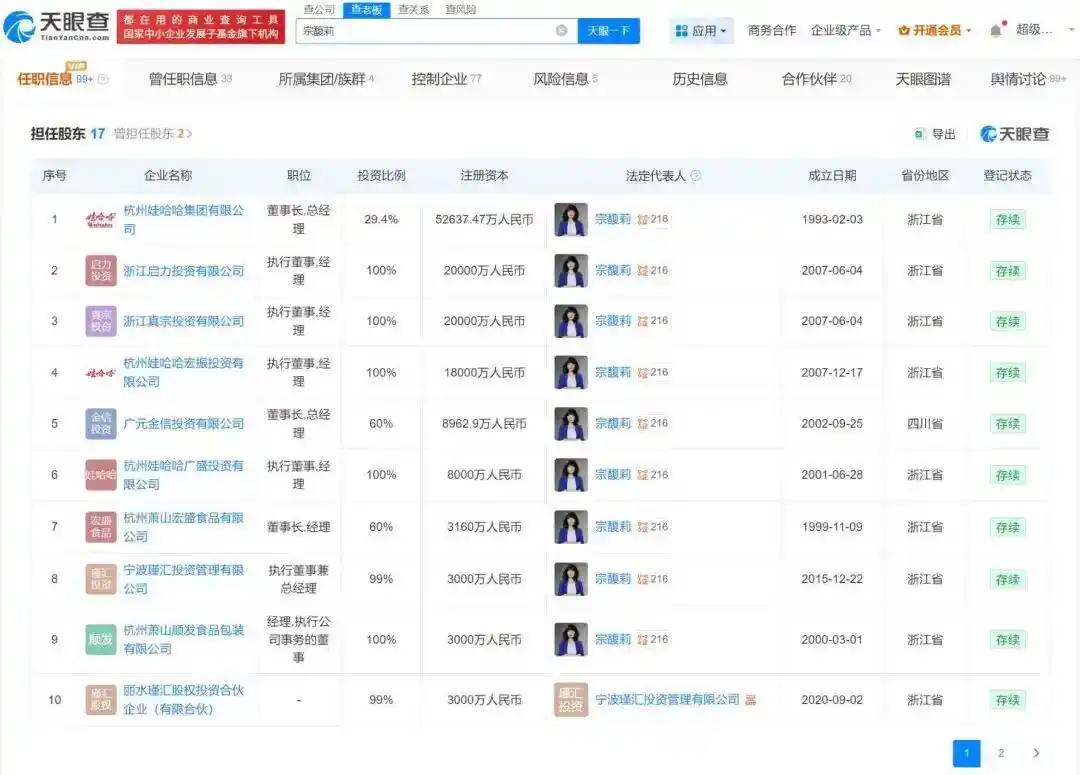

Image source: Skywatch

II. Importance of trademarks:
Not just a symbol, but a“voice“anda “moat“.
The case ofZong Fuli and“Wahaha“precisely reflects the multiple values of trademarks in modern business operation. The following points are worth pondering by all enterprises, especially those who have the ambition to go to sea.
1. Trademark is an“exclusive right“and“exclusive territory“.
When a brand obtains a registered trademark, it obtains the right to use the trademark exclusively in a specific category, that is to say, no one else can use the trademark in the same or similar category, and will not infringe on your trademark rights. This is a kind of legal“right of speech“. This exclusivity prevents others from rubbing off on you, riding on your trademark, or confusing the market in the face of fierce competition.
If a trademark is unregistered or incompletely registered, it is often passive in legal disputes. Even if you rely on“prior use“to claim your rights, you will have to pay high law firm costs and burden of proof.
In Zong Fuli’s case,although the trademark“Wahaha“belongs to the group, the actual use of the right to be constrained, and she may evenbe limitedby the unanimous“trademark use authorization“.This exclusive right attribute of the trademark is thekey toher being“stuck“.
2、Trademark is the core anchor of brand story and emotional connection
In the minds of consumers, brand name, logo, trademark is a kind of“emotional symbol“.When people see“Wahaha“, they may recall the impression of childhood drinks, nutrient solution era, or the national sentiment represented by the brand. Behind this brand equity is the accumulation of years of market operation and consumer trust.
Once a brand name is changed and a new trademark is launched, the biggest risk is not the legal aspect, but the“emotional flight“of consumers: will they be willing to accept a new name? Will they mistake it for a copycat or a fake? From the point of view of public opinion, there are netizens complained,“do not read the news, see Wa Xiaozong thought it was some kind of miscellaneous brand drinks.
Trademarks are therefore not only legal assets, but also carriers of emotion, trust and identity. Companies must be careful to maintain this emotional bond when replacing or launching a brand.

Figure /Relationship mapping of Zong Fu Li’s related companies , Source: Enterprise Search
3, trademarks are capital assets and trading chips
In asset restructuring, financing, mergers and acquisitions, licensing and other business operations, trademarks are often“soft assets“that can be valued, transferred, licensed or pledged. In some industries, trademarks are even more valuable than physical assets.
For the Wahaha system, the value of trademarks has been estimated at hundreds of billions of dollars.
As you can imagine, once this card can becontrolled“independently“, it may generate great leverage in capital operations.
But precisely because trademarks are assets, they are also more likely to be the subject of competition. Whether it is a property rights arrangement or a future brand licensing agreement, a clear definition of control of the trademark is essential.
4.Trademark strategy means“forward-looking layout“.
Trademarks are not used once and done, it also involves future extension, new product lines, cross-category and cross-country registration strategies. If the layout is not comprehensive enough at the beginning, it may be limited in the future innovation, cross-border or overseas.
For example, if a beverage company wants to expand its business in health care, tea, functional beverages, recreational food, etc. in the future, it needs to register trademarks in multiple categories. If it only registers the beverage category, it is likely to encounter“no right“wind controlin the cross-category.
Zong Fuli in the“Wa Xiao Zong“project, it is the early layout of a number of categories of trademarks, in order to prevent future obstacles.
This is a dimension that all brands must think about when building a trademark system.
5、Trademark rights is the brand lifeline
In the era of trademark disputes, infringement lawsuits, counterfeit products, and copycat imitations, brandsmay be gradually marginalizedif they are afraid to“fight“with their trademarks. Many well-known brands have therefore set up intellectual property teams, or even specialized trademark management departments and brand protection groups.
Zong Fuli’s new“Wa Xiao Zong“must also face the problem: the initial stage may encounter imitation, rubbing brand, confusion infringement and other risks, she must take the trademark as a weapon, build up a“moat“.
In short, trademarks have been given a deeper function than ever before in modern business:
It is not only a logo, not simply copyright, but also control, assets, emotional ties, strategic resources. For entrepreneurs, brand leaders, do not understand the trademark, ignoring the trademark, is the same as giving up the core of the brand a“bottom card“.
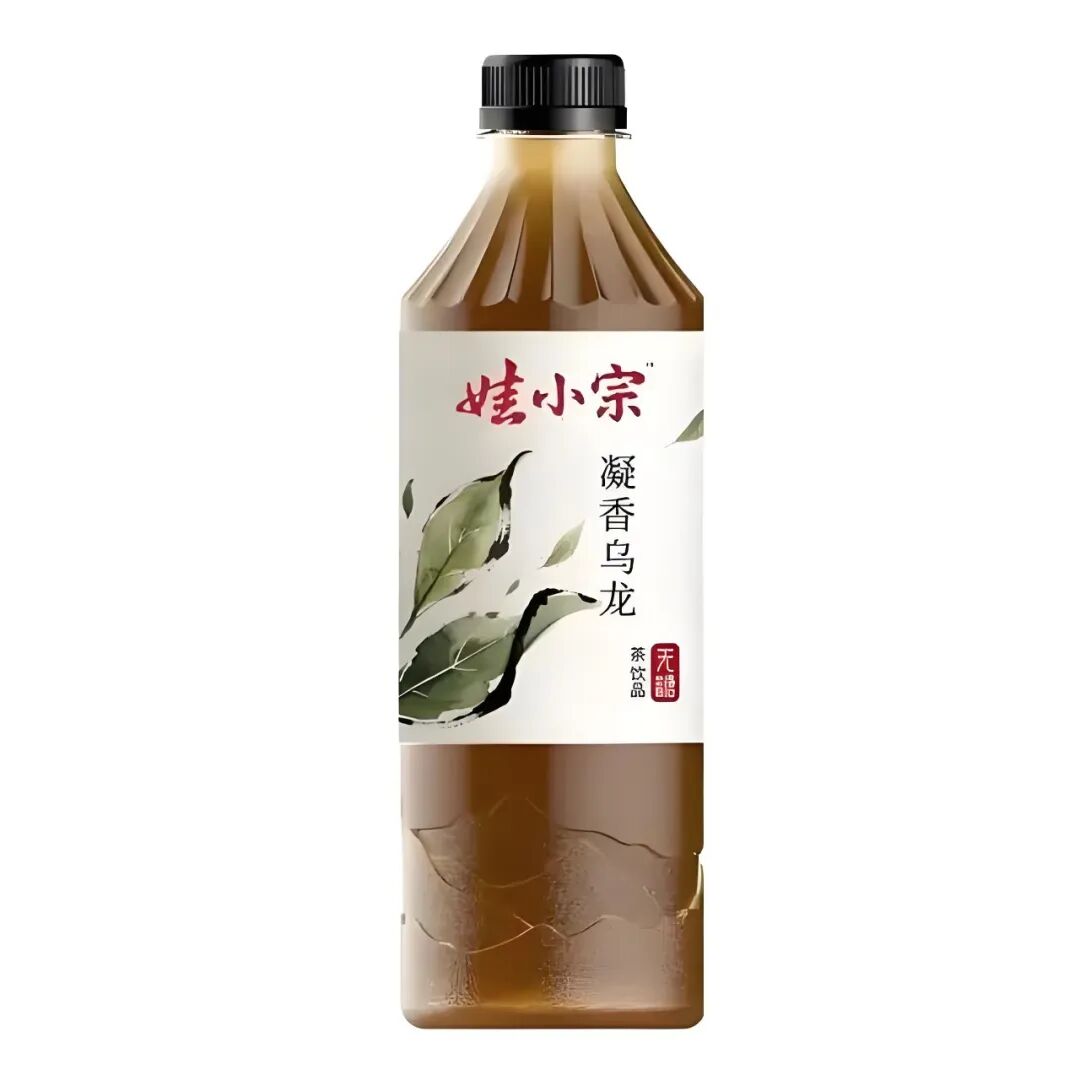
Source: Internet

Third, Singapore trademark application strategy:
Practical roadmap for seafarers
Since“trademark“is so important, how to do a good job of trademark protection layout in the international market for enterprises with overseas or international market ambitions? This article takes Singapore as an example, from the institutional environment to the application process, practical advice step by step to make it clear.
1、Why choose to register a trademark in Singapore?
Singapore has several advantages in the Southeast Asian and even global markets:
①Stable legal environmentand sound intellectual property protection, with the Intellectual Property Office of Singapore (IPOS) asthe competent authority;
② Singapore is a signatory to the Singapore Treaty on the Law of Trademarks, which simplifies the trademark registration process and shortens procedural hurdles.
③Opentoforeigners/foreign companies, there is no requirement for the applicant to be a Singaporean citizen or company, as long as it is submitted through an agent.
④ If the brand layout Southeast Asia or Asia-Pacific market, Singapore registration can be used as a“hub“, and can be one of the designated countries of the Madrid Trademark System (international registration).
⑤ Relatively fast registration cycle(usuallyaround6-10monthsif no objections or complex corrections)
(vi) The registration is valid for10yearsafter successful registrationand may be renewed for an unlimited number of times, with each renewal gaining another10years.
Based on the above characteristics, many Chinese enterprises choose to land in Singapore as the first stop in the Southeast Asian market and use it as a springboard to expand trademark protection to neighboring countries.
2、The basic process of Singapore trademark registration (four-step method)
According to the information, the application for trademark protection in Singapore can be almost“onlineDIY”, which can usually be summarized into4steps.
Step 1: TrademarkSearch/Similar Trademark Search
Before filing a formal application, it is important to check whether similar or dissimilar trademarks already exist to avoid refusal or opposition.IPOS Singaporeprovides an online“Similar Trade Marks”search system.
If highly similar logos or text combinations occur, the logo design or categorization should be rethought.
It is also recommended to conduct cross-border searches in international databases and target market trademark databases to prevent future cross-border infringement risks.
Step 2: Submission of application
Trademark applications can befiledthrough theIPOS Digital Hubor online filing platforms (e.g.,FormTM4)
The information required for the application includes:
① Name and address of the applicant (company or individual);
② Proposed registered trademark (text logo, graphic or combination; if color pattern, submit more than one copy);
③List of goods/servicesto be applied forand list of sub-items ( 45 categoriesaccording to Nice Classification);
④If priority is claimed (if an application has been filed in a Paris Agreement member country), a certificate of priority and an English translation must be submitted;
⑤ If there is a literal meaning, foreign language or Chinese language interpretation, a translation note should be attached.
After submission,IPOS will first conductaformal review (completeness and compliance of documents) and, if satisfactory, issue anAcknowledgement of Application.
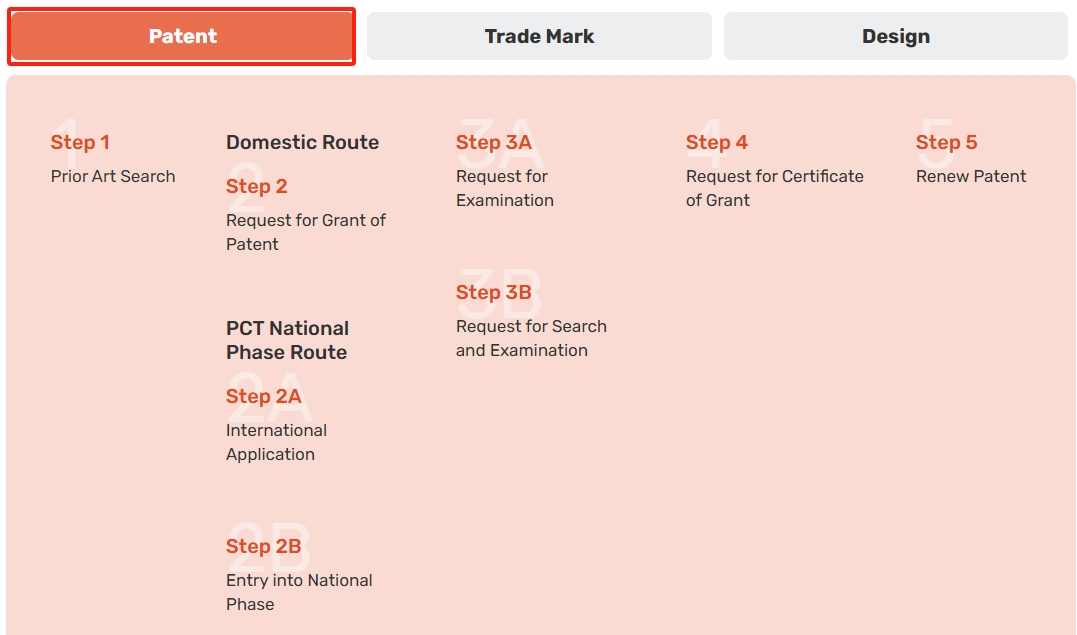
Source: IPOS Singapore
Step 3: Substantive examination and publication of the trademark (opposition period)
After acceptance,the IPOS conducts a substantive examination to determine whether the mark is distinctive and whether it conflicts with prior marks. If there are no objections or corrections, the trademark will be published (usually for 2 months), during which time any third party may file an opposition. If there are no objections, or if the objections are rejected, the trademark will be registered.
Step 4: Successful registration and certificate issuance
After the expiration of the publication period, if no valid opposition has been filed,the IPOS will approve the registration and issue a certificate of registration (usually an electronic certificate of registration) The trademark is effective as of the date of filing and the registration is valid for a period of10years and may be renewed prior to expiration.
If a refusal or opposition is encountered during the filing process, the applicant may file a response, an application for adjustment (e.g., reduction of classification, modification of the mark’s drawing), or an administrative review proceeding.
The whole process, if smooth and uncontested, usually takes6-10months.
3. Practical advice and risk prevention
The following points should be noted in the course of the operation:
Avoiding Conflicts with Prior Trademarks
The search must be strict enough to look not only for“identical“, but also for possible conflicts of sound, shape, meaning and combination.
②Category selection should be forward-looking
In the initial application should be a good prediction of the future expansion of the category, should not apply for too narrow. If the future expansion of the product line, it may be blocked by the lack of categories.
③Language and artwork submission should be carefully prepared
If the trademark is a colorful pattern or combination of graphics, multiple copies of different color versions should be submitted; if the trademark contains a literal meaning, translation instructions should also be attached.
④ Appointment of Agent, Geographical Address
For overseas applicants, it is usually necessary to appoint a Singapore registered trademark agent to file the application. A stable Singapore address must also be provided for contact.
⑤Response Strategies for Oppositions/Refusals
In case of opposition orrejectionby IPOS , it is necessary to respond and submit defense documents in a timely manner; it is also possible to consider modifying the trademark design or limitingthe scope of goods/services to resolve the dispute.
⑥ Renewal and Use Obligations
A registered trademark may be subject to a petition for revocation if it is not used for a long period of time within five years after registration. Therefore, the trademark should be put into use in a timely manner after application and evidence of use (e.g., packaging, publicity, invoices, etc.) should be retained.
⑦Monitoring and Rights Defense
Successful registration is just the beginning, but you need to monitor the market regularly to prevent infringement and copycatting. Consider registering a combination of trademarks (e.g.word mark + logo mark) to increase the level of protection.
⑧InternationalLayout/Madrid System
If you want to extend protection in multiple countries in the future, you can enter Singapore through the Madrid system, and also in Singapore as one of the designated countries. However, it should be noted that the Madrid route and the direct application route are different in terms of timeliness, cost and opposition strategy.


Figure: Singapore Trademark Registration, Design Process, Source: IPOS

Fourth, back tothe “Wahaha“incident:
Triple Takeaways from a Trademark Perspective
Bringing the above trademark strategy back tothe drama ofZong Fuli and“Wahaha/Waha Xiaozong“, we may be able to see more profound rules and lessons.
Takeaway 1: Trademark control may be more central than operational rights
In many families or large groups, management rights and capital rights are often regarded as the two core rights. In this case, however, the right to control trademarks can even be the“gate“that separates the two.
Even with the right to operate, without the right to use the trademark, it may be trapped like an“empty shell“. If Zong Fuli wants to really take the helm, she must obtain, or bypass, or reset the trademark control right.
This is a cautionary lesson for many medium to large branded companies and family businesses:
Never be lax, delayed or ambiguous about trademark ownership and use rights. The system of authorization, use, licensing and transfer of trademarks should have been designed in the internal governance mechanism of the enterprise.
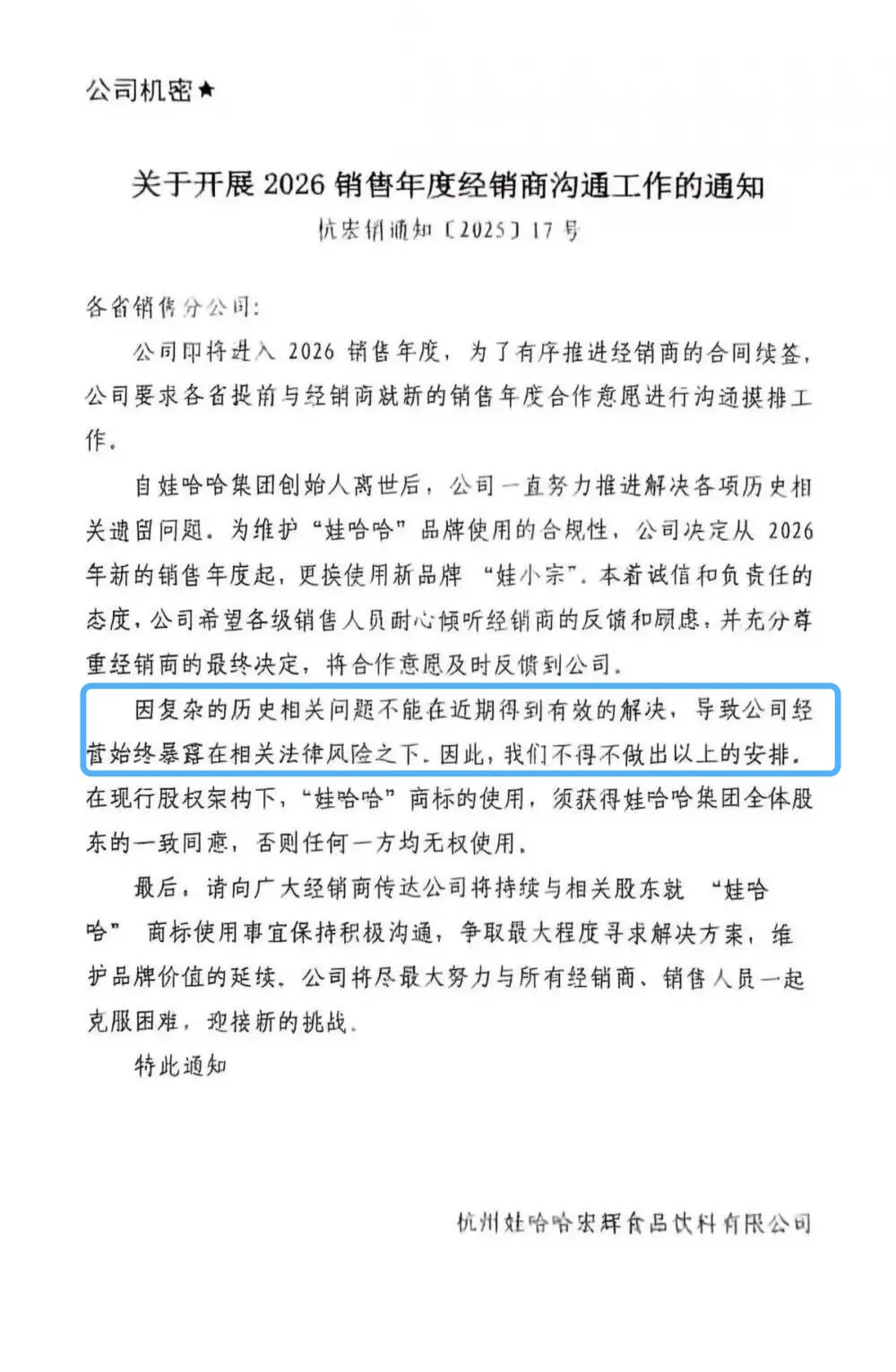
Source: Wahaha, deleted
Inspiration 2: Name changeis a global game, not simply remove the old label and change a name.
“Wa Xiaozong“is not simply“continue to sell drinks under a different name“. It involves:
Access downstream: willingness of dealers to cooperate;
Market perception: whether consumers recognize the new name;
Significant replacement costs for channel inventory, product packaging, logistics labels, promotional materials, etc;
Legal risks: opposition by others, trademark disputes, risk of confusion;
Brand equity fragmentation: how the original brand emotions are transitioned and articulated.
Therefore, changing the logo is a huge project to rebuild brand equity, rebuild trust and restart communication, rather than a simple technical operation.
In this regard,“Wa Xiaozong“preliminary layout of trademarks, multi-class application, it is particularly important. Only to make the trademark asset chain is complete, the legal protection is complete, it is possible to let the new brand stand.
Inspiration 3: Going out should have the trademark awareness of the sea
If the future“Wa Xiaozong“intends to go to Southeast Asia, East Asia or a wider range of markets, then trademark protection must be synchronized from the domestic to international efforts. This includes the layout of the market like Singapore first, docking Madrid system, cross-border combination of trademark strategy.
If a trademark is registered or opposed in a certain country in the future, the possibility of brand expansion will be greatly inhibited. Therefore, even if the currentstageis“domestic reorganization“, it is still necessary to lay out the international trademark protection early.
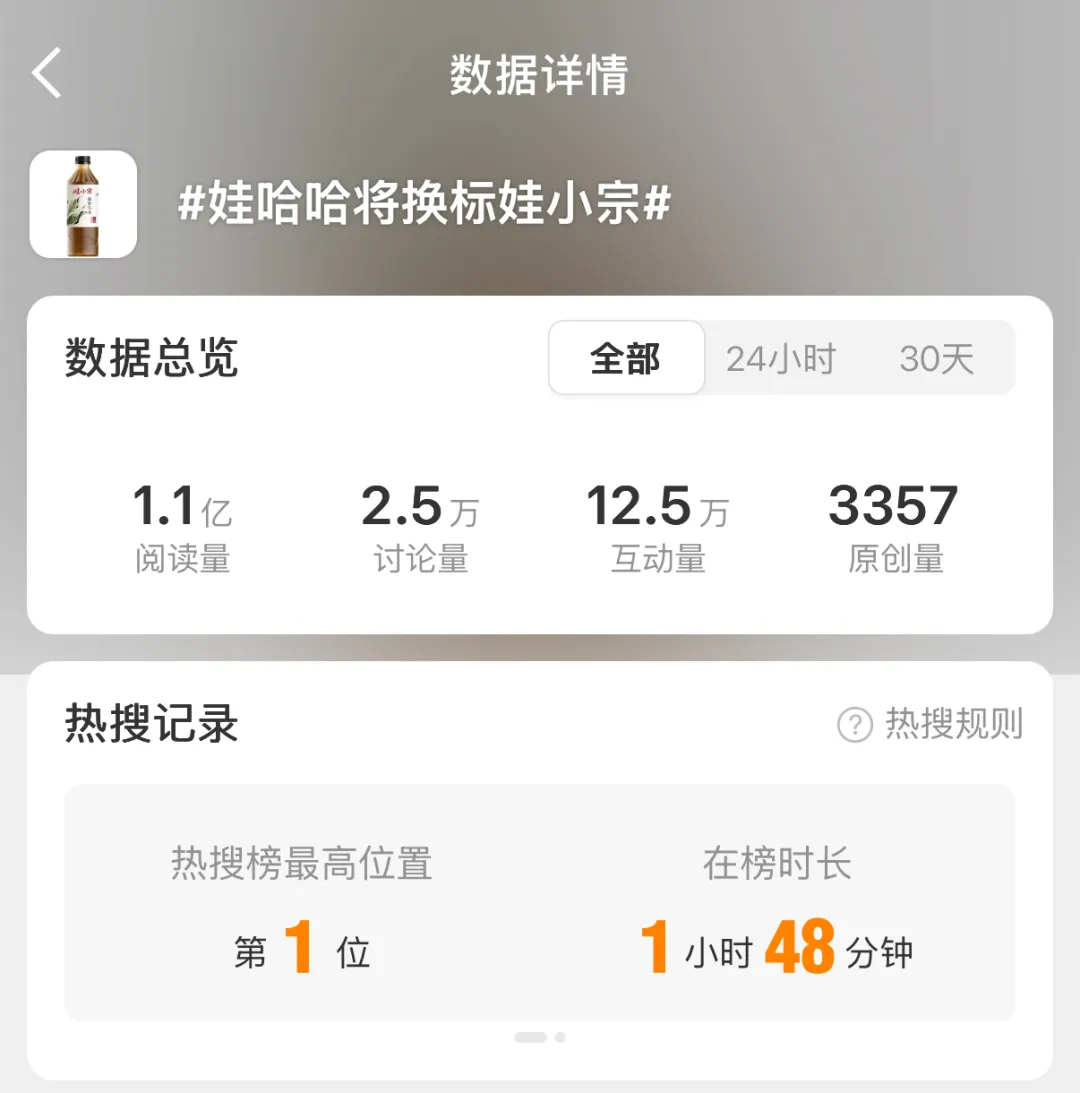
Source: Internet
Conclusion: Trademarks, both as a shackle and a launching pad
Zong Fuli’s resignation and“Wahaha→Waha small Zong“turn, on the surface of the family business power struggle, governance rupture of the magnifying glass; deeper look, it is the brand strategy, trademark rights to enable the reconstruction of the future path options. As the community commented these days: trademark this card, heavier than you think.
For all brand practitioners, entrepreneurs, especially for the international market, seeking long-term sustainable development of the boss, this storm is not only drink beverage industry“news“, but also a lesson in trademark strategy. You can deny it, you can ignore it, but in the future market competition, no“trademark weapon“brand, sooner or later will be forced to retreat.
If you subsequently intend to layout trademarks in Southeast Asia or Singapore, registered trademarks, ready to land overseas, we can provide you with specific cases, cost estimates, agent recommendations, process comparison and other more in-depth services.
Note:References from Phoenix Finance, Red Star News, Sina Finance,21stCentury Business Herald, Enterprise Search, Tianyecha, VentureBang, Oriental Fortune,IPOSSingapore, United Morning Post, Wahaha, comprehensive news reports, reprints must indicate the source, infringement of the deletion of contact.
